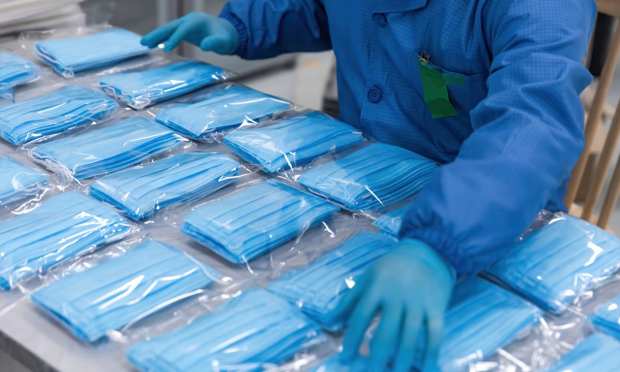How Project N95 Opens The PPE Market To Buyers In Need

At the height of the pandemic in the U.S., an unprecedented surge in demand for medical equipment like N95 masks, respirators and isolation gowns has created a nightmare procurement scenario for the healthcare industry.
Not only did it become an often insurmountable challenge for medical buyers to source and procure the necessary personal protective equipment (PPE), but failures across the supply chain — including fraud — have plagued the market, leading authorities including FinCEN and the Federal Bureau of Investigation to sound the alarm for both buyers and suppliers in the market.
Many of the biggest points of friction that emerged in the spring could be solved through technology, according to Anne Miller, executive director at Project N95, a new nonprofit described as the “National Critical Equipment Clearinghouse.”
Speaking with PYMNTS, Miller described where the most detrimental breakdowns in the PPE supply chain occurred, and outlined the ways in which a digital-first B2B eCommerce model mitigate those pain points as COVID-19 cases surge across the U.S. once again.
Know Your Supplier
One of the most challenging aspects of the B2B PPE market amid the pandemic has been a surge in unfamiliar vendors stepping onto the scene. Not all of them had the best intentions, according to Miller.
“What we saw was, on a global basis, everyone was trying to buy product. We were bidding against each other, to some extent,” she explained. “As a result, there were a lot of new entrants and a lot of new suppliers on the market — some people trying to help, and some trying to make a buck.”
Even entities with good intentions created headaches for buyers. As Miller described, the PPE market is highly regulated, with strict requirements to ensure that products like gowns and masks meet federal performance standards. At the height of the pandemic, many manufacturers that had not initially operated in the PPE space adjusted their business models to begin producing medical equipment in an effort to help the cause.
The unintended consequence of this, however, was a slew of unfamiliar vendors without a track record offering products that may or may not have met quality requirements.
A combination of bad actors, inexperienced suppliers and an overwhelming spike in demand led to an environment in which problems like fraud, unfulfilled orders, delayed shipments and other breakdowns ran rampant. And not every issue was traced back to the vendor: Legitimate suppliers also faced issues like late payments, incorrect payments and non-payment.
Leveling The Playing Field
On the buyer side, the PPE market climate also exposed another massive point of friction in the procure-to-pay process: an imbalance of buying power.
According to Miller, there are three categories of buyers in the PPE market. They include large players like big hospital systems, smaller entities like clinics and private practices, and even smaller buyers like hospitals in rural locations and tribal nations.
These last two categories are often shut out of the market, she explained, because they lack the resources to meet minimum purchasing requirements.
“Big entities are able to contract at the large volumes manufacturers need,” said Miller. “But when the minimum order quantity is 10,000 units, that smaller, independent practice, or the rural clinic, or the tribal population can’t necessarily meet that minimum order quantity, so they don’t have access to the market.”
This created demand for group purchasing capabilities, but amid the chaos, it became nearly impossible to know how to band together and efficiently procure PPE, then accurately distribute that product.
A Digital-First Approach
For the biggest pain points on both the buyer and seller side, a digital-first procure-to-pay strategy offers relief. That was the basis behind Project N95, which established a digital marketplace for buyers and sellers to connect.
For buyers, the nonprofit can support group purchasing models, vetting each vendor that comes on board to ensure the products they manufacture are up to standard and that all orders will be fulfilled (the organization operates with a warehouse to pack and ship orders).
For sellers, the organization acts as a trusted middleman to ensure that companies are paid promptly. Indeed, according to Miller, there is often a down payment requirement, or payment will be made upon delivery. Yet Project N95 still allows buyers to pay on net terms.
For the school nurse who requires a purchase order and net-30 days to procure a small number of N95 masks, for example, this business model addresses some of the biggest challenges that had previously shut them out of the market.
“Being able to bring everyone together electronically, roll up all of their individual needs and then place that order in aggregate really helps to give access to that smaller buyer who couldn’t otherwise participate,” said Miller.
Working with technology partners, including eCommerce-as-a-Service firms VTEX and Loop Integration, became a vital strategy to optimize the PPE procure-to-pay market for Project N95. As new COVID-19 cases once again break records across the country, demand for such equipment continues to rise. Yet even after a vaccine emerges, Miller said technology solutions that can address the needs of both buyers and suppliers in this space will be critical.
Already, new challenges are emerging: According to Miller, there is evidence of a glove shortage, which could severely impede vaccine administration efforts.
“I tell my kids it’s the new normal to wear a face mask,” she said. “I hope that a vaccine will come out and we can declare mission accomplished, but until we know that COVID is really under control, we expect to be here to supply anybody who needs access to PPE and can’t get it.”
